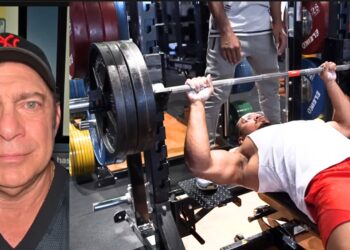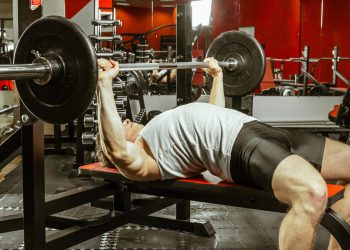Bodybuilding is one of the best ways to transform your body. Using dumbbells, barbells, resistance machines, and your body weight, you can sculpt the physique of your dreams.
New Year is the ideal time to start a bodybuilding program. After the holidays, you’ll be more than ready to start eating right and be more active. Transformations don’t happen overnight but, with dedication and discipline, you can build a body you can be proud of.
But, don’t make the mistake of trying to do too much too soon. That’s a recipe for disaster. About 80-percent of New Year’s Resolutions fail within six weeks, usually because people overcommit and try to bite off more than they can chew (1).
So, instead of following a bodybuilding program created for the next Mr. Olympia, learn to walk before you run with our New Year’s Resolution Beginners Bodybuilding Program. It’s designed for exercisers with very little or no previous experience and is the perfect introduction to bodybuilding training.
New Year’s Resolution Program – Overview
This beginner’s bodybuilding program involves training your upper body one day and your lower body the next. You’re going to alternate between the two workouts and train either three or four times per week, i.e.,
- Monday – Upper body
- Wednesday – Lower body
- Friday – Upper body
- Monday (week 2) – Lower body, etc.
Or:
Level Up Your Fitness: Join our 💪 strong community in Fitness Volt Newsletter. Get daily inspiration, expert-backed workouts, nutrition tips, the latest in strength sports, and the support you need to reach your goals. Subscribe for free!
- Monday – Upper body
- Tuesday – Lower body
- Thursday – Upper body
- Friday – Lower body
The training days aren’t set in stone, and you’re free to move the workouts to fit your schedule. However, it’s generally best not to exercise more than two days in a row before having a rest day. That way, you’ll be well recovered for each workout and able to give every one your best effort.
But, before you start either of the workouts, make sure you spend 5-10 minutes preparing your muscles and joints for what’s to follow. Do a few minutes of easy cardio, such as jump rope, elliptical, rowing, or brisk walking, followed by some dynamic mobility and flexibility exercises for the muscles and joints you’re about to use, e.g.:
- Shoulder and arm circles x 10
- Shallow progressing to deeper squats x 10
- Waist side bends and twists x 10
- Shallow progressing to deeper lunges x 10
- Overhead reach and pulldown x 10
Upper Body Workout
This workout focuses on your chest, back, shoulders, and arms.
| No. | Exercise | Sets | Reps | Recovery |
| 1 | Bench press | 3 | 8-12 | 90 seconds |
| 2 | Seated cable row | 3 | 8-12 | 90 seconds |
| 3 | Seated DB shoulder press | 3 | 8-12 | 90 seconds |
| 4 | Lat pulldown | 3 | 8-12 | 90 seconds |
| 5 | Cable crossover | 2 | 8-12 | 90 seconds |
| 6 | EZ biceps curl | 2 | 8-12 | 90 seconds |
| 7 | Triceps pushdown | 2 | 8-12 | 90 seconds |
Exercise instructions
Generally speaking, there are two ways to do any exercise – the right way and the wrong way. The right way is safe and effective, while the wrong way is less effective and may even be dangerous. Study the instructions below, watch the videos, and make sure you always do the exercises in your program correctly.
1. Bench press
The barbell bench press is the king of upper body exercises. It works your chest, shoulders, and triceps. The bench press is also the second exercise contested in powerlifting.
The key to the bench press is NOT lifting with your ego, so don’t go too heavy too soon. Instead, focus on using light to moderate weights, controlling the bar, and maximizing the mind-muscle connection.
You can learn how to do bench presses here.
2. Seated cable row
This exercise is basically the opposite of the bench press. It works your upper back and biceps and ensures that the back of your body is as developed as your front. Take care to keep your back straight during seated cable rows. Sit up tall and don’t slouch or round your lower back.
Find out how to do this exercise correctly here.
3. Seated DB shoulder press
DB stands for dumbbells. This overhead pressing exercise works your shoulders, and doing it seated provides your lower back with plenty of support.
Don’t worry if the dumbbells wobble or move at different speeds. You’ll soon learn to control them as you get used to the exercise. In fact, it’s that need for control that makes dumbbells such a powerful muscle-building tool!
Learn how to do seated DB shoulder presses here.
4. Lat pulldown
Lat pulldowns are another back exercise. So why does this workout involve doing two back exercises, you ask? Because the back is such a large, important muscle group!
Lat pulldowns also work your biceps, and every bodybuilder wants bigger, stronger biceps. This exercise uses the same movement as pull-ups, which you’ll hopefully progress to in the coming months.
You can learn how to do lat pulldowns here.
5. Cable crossover
Like bench presses, cable crossovers work your chest. But, unlike bench presses, the cable crossover is an isolation exercise and does not involve your triceps. Using a light to moderate weight, this exercise lets you really squeeze your chest for an intense workout.
Find out how to do cable crossovers here.
6. EZ biceps curl
The biceps are most bodybuilders’ favorite muscle to train. After all, there isn’t a bodybuilder alive who doesn’t want more muscular arms. Using a cambered EZ bar places your wrists in a more comfortable position, leaving you free to focus on developing this all-important muscle.
Find out how to build bigger biceps with EZ bar curls here.
7. Triceps pushdown
Triceps pushdowns target the muscle on the back of your upper arm. This is a simple yet effective exercise. Your triceps make up roughly two-thirds of your upper arm mass, so they’re not a muscle to be neglected! Use a straight bar, V bar, cambered EZ bar, or a rope handle as preferred for this arm-building exercise.
Learn more about triceps pushdowns here.
Lower Body Workout
A lot of novice bodybuilders don’t train their legs as hard or as often as they should. That’s a shame because the lower body makes up roughly 40% of your muscle mass, and not training your legs will have a significant impact on how you look.
Don’t make the same mistake. Instead, start your bodybuilding journey by paying as much attention to your legs as you do your upper body!
| No. | Exercise | Sets | Reps | Recovery |
| 1 | Goblet squat | 3 | 8-12 | 90 seconds |
| 2 | Leg press | 3 | 8-12 | 90 seconds |
| 3 | Leg curl | 3 | 8-12 | 90 seconds |
| 4 | Lunge | 3 | 8-12 per leg | 90 seconds |
| 5 | Standing calf raise | 3 | 8-12 | 90 seconds |
| 6 | Cable crunch | 2 | 8-12 | 60 seconds |
| 7 | Lying side hip raise | 2 | 8-12 per side | 60 seconds |
Exercise descriptions
As stated previously, there are two ways to do any exercise – the right way and the wrong way. Study the instructions below, watch the videos, and make sure you always each exercise correctly.
1. Goblet squat
There are lots of different types of squats to choose from, but the goblet squat is arguably the best option for beginners. This safe yet effective exercise is easy to master but will still help build bigger, more muscular legs. All you need to do it is a single dumbbell or kettlebell.
Learn how to do goblet squats here.
2. Leg press
The leg press works many of the same muscles as goblet squats but with a machine and while providing plenty of back support. With no weights to balance, you are free to focus on working your legs hard but safely.
However, take care not to bend your legs too far and round your lower back, which could cause injury.
Find out how to do leg presses safely and correctly here.
3. Leg curl
While most leg exercises work your quadriceps and hamstrings, the quads on the front of your thighs are usually the more dominant muscle group. Doing leg curls is an easy way to fix this imbalance.
Level Up Your Fitness: Join our 💪 strong community in Fitness Volt Newsletter. Get daily inspiration, expert-backed workouts, nutrition tips, the latest in strength sports, and the support you need to reach your goals. Subscribe for free!
Learn more about leg curls here.
4. Lunge
Lunges are a bodyweight exercise that you can also do with dumbbells or barbells. Working one leg at a time, this move is an excellent way to ensure you develop both of your legs evenly.
It’s also a useful exercise for improving your balance and hip mobility. If you are new to lunges, do them without weights until you’ve mastered them.
Check out our guide to lunges to learn how to do them correctly.
5. Standing calf raise
Successful bodybuilding is all about attention to detail; you can’t afford to leave any muscle untrained, even if it’s not particularly prominent. The calves are a small but essential lower-body muscle. In fact, it’s probably the most visible leg muscle. Don’t neglect your calves; build them with standing calf raises.
Read more about standing calf raises here.
6. Cable crunch
Lower body workouts generally involve fewer exercises than upper body workouts. That means they’re the perfect time to train your abs! Cable crunches will save you from doing dozens of ineffective reps while lying on the floor. Like every other muscle, the best way to train your abs is by using moderate weights and medium reps.
Learn how to do cable crunches here.
7. Lying side hip raise
Where cable crunches work the muscles on the front of your abdomen, lying side hip raises work your waist. If you’ve always wanted a smaller, tighter waist, this is the exercise to do it. Make sure you do the same number of reps on both sides to develop your waist evenly.
Find out how to do the lying side hip raise here.
Fitness Calculators
Tools and calculators to achieve your fitness goals
- Calorie Deficit Calculator
- TDEE Calculator
- Intermittent Fasting Calculator
- Water Fasting Weight Loss Calculator
- Macronutrient Calculator
- Weight Loss Calculator
- Elliptical Calorie Calculator
Beginner Bodybuilder FAQs
Do you have a question about getting started in bodybuilding? We’ve got the answers!
Q: In the programs, what are sets, reps, and recovery?
A set is a group of reps, and reps is short for repetitions, which is the number of times you do each exercise. Recovery is the length of the rest between sets.
So, when the program says to do three sets of 8-12 reps with 90 seconds rest, you do the exercise somewhere between 8-12 times, rest 90 seconds, and then repeat that sequence twice more to make three sets.
Q: How much weight should I lift?
It’s impossible to tell you exactly how much weight you should lift, so you should self-select a load that fatigues your muscles within the prescribed rep range of 8-12 reps. If you can’t do eight reps, the weight is too heavy, but if you can do more than 12, it’s too light.
It may take a couple of workouts to determine your training weights, but that’s all part of the beginner bodybuilding experience.
Also, do your best to increase your weights every week or two. Your muscles are going to get stronger, and you need to challenge them with ever-increasing weights. Your progress will soon stall if you don’t try to lift a little more weight.
Q: Can I do different exercises to those listed?
As a beginner, you should mostly follow the workouts as they are written. The exercises we’ve selected are ideal for less experienced bodybuilders but are still effective.
If you must change the program, maybe because you don’t have access to the necessary equipment, make sure you use similar exercises that work the same muscles. For example, while it’s acceptable to do hack squats instead of leg presses, doing dumbbell curls instead of bench presses is not.
Q: My muscles are really sore – what have you done to me?!
Delayed onset muscle soreness (DOMS) is a common side-effect of intense exercise. It’s caused by the accumulation of metabolic waste products, muscle microtrauma, and inflammation.
All bodybuilders get DOMS, but it tends to be worse for beginners.
Don’t worry; it’ll become less noticeable over the coming weeks. Just spend a little longer warming up to get your stiff muscles working again, and take care not to do too much too soon, which is the leading cause of DOMS.
Q: What sort of diet should I follow to build muscle?
Nutrition is a big and sometimes complicated subject, but it doesn’t have to be! In simple terms, don’t fall for any fad diets, build your meal around nutritious whole foods, and consume plenty of protein. If you aren’t building muscle, make sure you’re eating enough calories.
Check out this bodybuilding diet for more information on what to eat to build muscle.
Q: Do I need to take supplements to build muscle?
A lot of bodybuilders use supplements so they can train harder and longer and recover faster. However, supplements are not compulsory, and you can build muscle without them, too.

That said, using some well-chosen supplements could help make your workouts a little more productive. Good options include:
Also Read: Bodybuilding Without Supplements
Q: Do I have to work out in a gym?
Training in a gym has several advantages. For starters, it means having access to a wide range of equipment. There will also be instructors and trainers there who can give you advice. That said, some bodybuilders prefer to train at home in garage gyms. You can also work out using just your bodyweight if you want a simpler, no-frills approach to training.
At the end of the day, the most important things are training consistency and intensity. Whether you choose to train in a gym or at home, so long as you work out hard and often enough, you’ll get the results you want.
Q: Do I need to do cardio, too?
Cardio works your heart, lungs, and circulatory system. It can help burn fat, control your weight, and it’s very good for your health. However, doing too much cardio could interfere with your bodybuilding progress.
Focus most your energy on bodybuilding training and limit yourself to 20-30 minutes of cardio 2-4 times a week. Remember what your priority is; as a bodybuilder, even a beginner, lifting weights should be primary workout.
Q: When should I switch to a new program?
Stick with this plan for as long as you can increase your weights and are making progress. If your progress starts to stall, it’s probably time for a new workout. However, just because you’ve been training for three months or so doesn’t mean you are ready for an advanced workout.
Seek out programs that are SLIGHTLY more demanding than this one. Doing too much too soon is an excellent way to end up burned out or injured.
You’ll find plenty of workouts on Fitness Volt, or you can learn to write your own bodybuilding program.
Beginner’s Bodybuilding Program – Wrapping Up
Whether you are new to bodybuilding or returning after a long lay-off, this program is designed to deliver the results you want. Simple, time-efficient, and effective, it’s the perfect springboard for your 2022 body transformation.
All you need to do is commit to working out 3-4 times a week. While it won’t change your body overnight, after just a few short months, you’ll be able to see increases in muscle mass and definition, and you’ll be stronger too.
So, don’t delay and start today. Make 2022 the year you build your best body ever!
References:
1 – PubMed: A large-scale experiment on New Year’s resolutions: Approach-oriented goals are more successful than avoidance-oriented goals https://www.ncbi.nlm.nih.gov/pmc/articles/PMC7725288/








